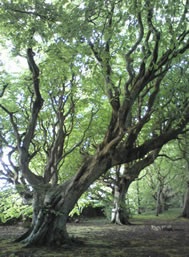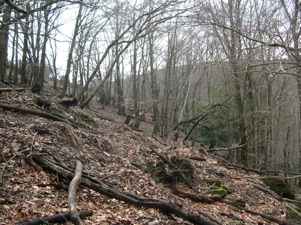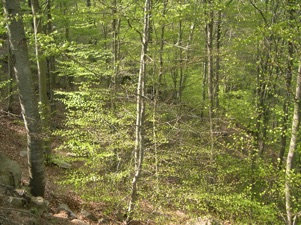Investigating impacts of management and climate change on European beech forest

The European beech, Fagus sylvatica, is one of the most important broadleaved trees in Europe, and one on which a diverse array of plants, animals and other organisms depend. This species is highly important for biodiversity, it acts as a keystone species in the habitats it defines and as an ‘umbrella species’ in conservation prioritisation. However, in many areas, beech forest communities are highly threatened and thus a target of conservation as Natura2000 areas under the European Union’s Habitat Directive (1992). For example, although beech is much planted for forestry, less than 10% of the recent natural distribution of Atlantic lowland beech forests remains and even within this current distribution, environmental change threatens the viability of large areas of remaining forest.
Climate change poses specific threats for beech and the species that occur with it. Warmer temperatures may promote population expansion at this species leading range edge, but increasing drought stress is already having a significant negative impact on growth at its trailing edge. The more direct impacts of man can speed or slow beech decline through changing forestry and conservation practices. However, man has exploited this species for centuries and its present distribution is partly the consequence of past generations planting and felling beech across the continent. Current European beech forests therefore result from a long history of human intervention and so appropriate and coordinated management of natural and seminatural beech forest is essential if we are to retain and expand this species and its associated biodiversity.
Old beech pollards at Llandudno



This project has two main strands, assessing the impacts of recent and historic management on the distribution of genetic diversity within the species and also looking at how climate change and extreme climatic events are likely to impact growth. The work forms part of the larger ‘European Beech Forests for the Future’ project which assesses the biodiversity and conservation implications of Natura2000 for this species, how the implementation of Natura2000 differs between different nation states and the implications of such differences for beech forest management and conservation.
Increased tree mortality and poor population condition in beech forest at the southern edge of its range
This project is funded by the UK Natural Environment Research Council as part of the FP7 ERA-Net BiodivERsA project European Beech Forests for the Future: Ecological, economical, and policy analysis of beech forest conservation under the Natura 2000 Network (BeFoFu).
Related publications
Cavin L, Jump AS (2017) Highest drought sensitivity and lowest resistance to growth suppression is found in the range core of the tree Fagus sylvatica L. not the equatorial range edge. Global Change Biology, 23, 362-379
Hacket-Pain AJ, Cavin L, Friend AD, Jump AS (2016) Consistent limitation of growth by high temperature and low precipitation from range core to southern edge of European Beech indicates widespread vulnerability to changing climate. European Journal of Forest Research, 135, 897-909
Winkel G, Blondet M, Borrass L, Frei T, Geitzenauer M, Gruppe A, Jump A, de Koning J, Sotirov M, Weiss G, Winter S, Turnhout E (2015) The implementation of Natura 2000 in forests: a trans- and interdisciplinary assessment of challenges and choices. Environmental Science & Policy 52 23-32
Sjölund J, Jump AS (2015). Coppice management of forests impacts spatial genetic structure but not genetic diversity in European Beech (Fagus sylvatica L.). Forest Ecology and Management, 336, 65-71
Winkel G, Blondet M, Borrass L, Geitzenauer M, Gruppe A, Jump A, de Koning J, Sotirov M, Weiss G, Winter S, Turnhout E (2014) Natura 2000 et les forêts de l’Europe: comprendre et relever les défis de la mise en œuvre. Revue Forestière Française 6, 743-750
Winkel G, Jump A (2014). Perspectives on Forest Conservation – building evidence at the frontier between policy and conservation science. Biodiversity and Conservation, 23, 3359-3372
de Koning J, Turnhout E, Winkel G, Blondet M, Borras L, Ferranti F, Geitzenhauer M, Sotirov M, Jump AS (2014). Managing climate change in conservation practice: an exploration of the science management interface in Beech forest management. Biodiversity and Conservation, 23, 3657-3671
Cavin L, Mountford E, Peterken G, Jump AS (2013). Extreme drought alters relative competitive dominance within and between species in a mixed forest stand. Functional Ecology, 27, 1424-1435.
Sjölund J, Jump AS (2013). The benefits and hazards of exploiting vegetative regeneration for forest conservation management in a warming world. Forestry, 86, 503-513
Jump AS, Rico L, Coll M, Peñuelas J (2012). Wide variation in spatial genetic structure between natural populations of the European beech (Fagus sylvatica) and its implications for SGS comparability. Heredity, 108, 633-639
Barbeta A, Peñuelas J, Ogaya R, Jump AS (2011). Reduced tree health and seedling production in fragmented Fagus sylvatica forest patches in the Montseny Mountains (NE Spain). Forest Ecology and Management, 261, 2029-2037.
Bacles CFE, Jump AS (2011). Taking a tree’s perspective on forest fragmentation genetics. Trends in Plant Science, 16, 13-18.
Jump AS, Cavin L, Hunter P (2010). Monitoring and managing responses to climate change at the retreating range edge of forest trees. Journal of Environmental Monitoring, 12, 1791-1798.